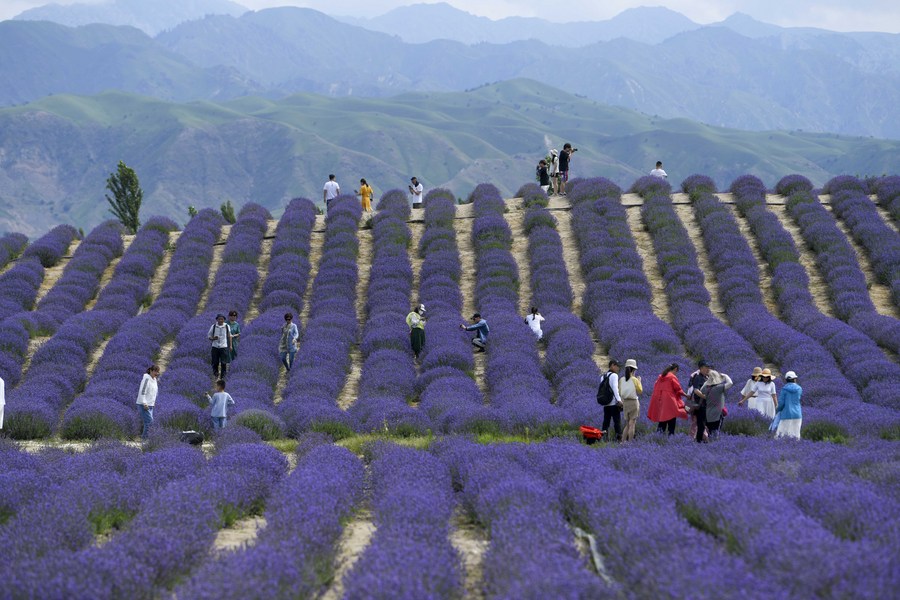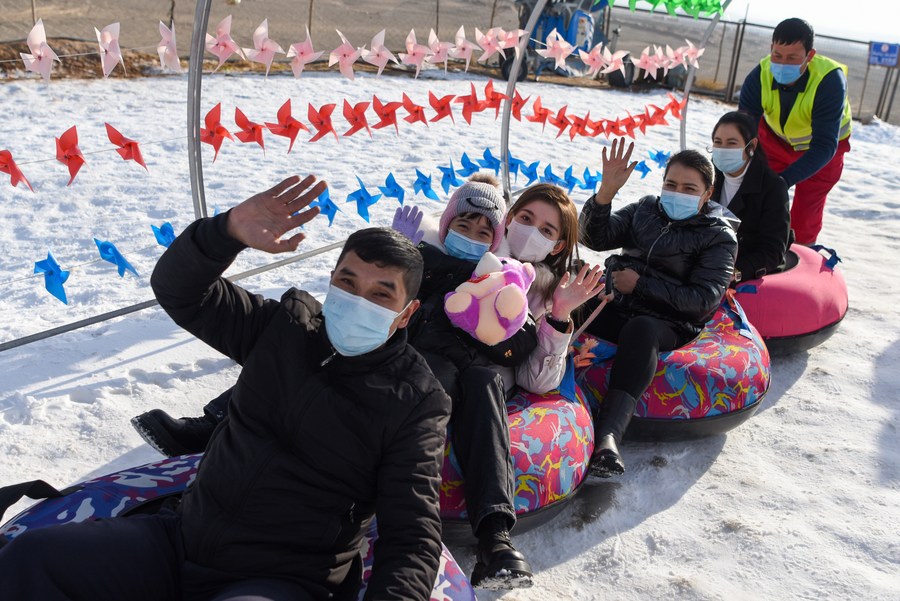
On the Duku Highway in northwest China's Xinjiang Uygur Autonomous Region, a long stream of cars, SUVs and mini RVs can be seen filing past numerous breathtaking scenic spots.
The 561-km highway that runs through the majestic Tianshan Mountains is only open from June to October every year and is believed to be the most beautiful route in China.
In recent weeks the highway has experienced a significant increase in traffic, with vehicles pouring in from all over the country.
This is just one of the many instances indicating that with China fine-tuning its COVID-19 prevention measures and Xinjiang offering a series of incentives, tourism is regaining vitality across the region.
An overall tourism boom in recent years has, meanwhile, encouraged more people of different ethnic groups in Xinjiang to join the sector and earn a piece of the pie, resulting in more income and greater prosperity.

Tourists visit a lavender field in Huocheng County, northwest China's Xinjiang Uygur Autonomous Region, June 19, 2022. (Xinhua/Zhao Ge)
CONVENIENT TOURISM
Xinjiang comprises 1.66 million square kilometers or approximately one-sixth of China's total land area. Traveling to Xinjiang and visiting its various tourist spots used to be an arduous task.
That, however, is a thing of the past. Today, Xinjiang has 24 civil airports, with the 24th one opening last month and more under construction.
There are other travel options available for those who like taking road trips, so they can enjoy the scenic views along the way. Last month, the Hotan-Ruoqiang Railway was officially put into operation, marking the inauguration of the world's first desert rail loop line. The third highway traversing the Taklimakan Desert opened to traffic last week.

Aerial photo shows a new highway traversing the Taklimakan Desert in northwest China's Xinjiang Uygur Autonomous Region, June 23, 2022. (Xinhua/Gu Yu)
Furthermore, tourists have a variety of lodging options. According to official data, Xinjiang currently has 386 star-rated hotels and 5,643 homestay facilities.
In addition to improving its tourism infrastructure, Xinjiang has rolled out a series of measures to stimulate the sector and has since been incentivizing local governments to attract tourists from outside the region.
One of the latest trends is local officials promoting tourism through short videos and live streams. He Jiaolong, deputy head of the culture and tourism department of the Kazak Autonomous Prefecture of Ili, is the first of about 25 officials involved in such promotional efforts.
In October 2020, a video of her riding a horse across snowy fields in Zhaosu County went viral. And the number of visitors to Zhaosu increased fivefold the following year, as people flocked to see horses galloping in the snow.
Although some prefectures, including Zhaosu, saw fewer tourists in the first half of this year compared to the same period last year, the volume in June increased by 14 percentage points from that in May, said He, adding that she is confident the momentum will continue.
With more than 5 million followers on social media, He said she is glad to have blazed a trail for her colleagues in other places. "I hope more will join us. We need many more people to introduce our wonderful Xinjiang to the world."
RICHER EXPERIENCES
Wu Beilei, a tour guide with 14 years of experience, said he has been racking his brains on what else he can offer to his clients, apart from traditional sightseeing, self-driving, hiking and camping.
"Ten years ago, tourists came to Xinjiang just to take beautiful pictures and put them into albums. Now their needs have changed significantly," Wu said.
This has sparked innovation in the tourism industry in Xinjiang and contributed to the emergence and growth of niche, themed and cultural tourism kinds.

Tourists play on snow tubes at Oynak ski resort in Moyu County, northwest China's Xinjiang Uygur Autonomous Region, Jan. 9, 2022. (Xinhua/Ding Lei)
For example, due to the Beijing Winter Olympics, ice and snow tourism has boomed in Xinjiang, as the region is particularly rich in such resources. The region currently boasts more than 80 ski resorts. During the week-long Spring Festival holiday in February this year, Xinjiang received about 3.6 million tourists.
Meanwhile, many counties are tapping into their unique advantages, history and culture for inspiration. Known as the hometown of "heavenly horses," Zhaosu has focused on horse-themed tourism, with its equestrian shows, museum and other attractions drawing more than 6,000 visitors every day.
At the picturesque Nalati grassland in the neighboring Xinyuan County, more than 1,000 visitors gather every night to watch performances based on the legendary story of a Han Dynasty (202 B.C.-220 A.D.) princess and a chief of the nomadic Wusun people dating back about 2,000 years.
Wang Hong, a tourist from east China's Jiangsu Province, joined the performers for a group dance during an interactive session of the show. "Dancing with them makes me feel relaxed and happy. I've learned a lot about local history and culture as well," he said.
HAPPY FACES
Dilnur Ablimit is one of the small-time business owners in the ancient city of Kashgar who makes a living from tourism. She runs a photo studio and rents out traditional Uygur costumes to tourists for photoshoots, while also assisting with their makeup.
"I want my clients to experience how fascinating the Uygur culture is and make friends through this cultural experience," said the 24-year-old entrepreneur.
She recalled with delight how a tourist from south China's Guangdong Province had promoted her service on social media platforms and invited her for a trip to Guangdong.
"I'll go and visit her someday, but now I'm too busy," Dilnur Ablimit said. Her studio received more than 20 guests every day during the last few months, and she has recently hired two makeup artists and two photographers as her assistants.

Tourists take photos at a homestay in the old town of Kashgar, northwest China's Xinjiang Uygur Autonomous Region, June 12, 2022. (Xinhua/Ding Lei)
Official statistics show that more than 54,000 new jobs related to tourism have been created since 2018, and 1.5 million people are working in relevant service industries. According to tourism experts, this would not have been possible without social stability.
Two years ago, Elnur Hisamdin found a job in a bakery about 500 meters away from her home in the Liuxingjie community in Yining City, where residents of 13 ethnic groups live in harmony.
Having lived there for years, she is an eyewitness to how government-led efforts have improved the conditions of the neighborhood and turned it into a popular tourist destination featuring an accordion museum, cultural parks, and numerous shops, restaurants and B&Bs.
She is pleased that business at the bakery is growing as a result of an influx of tourists. The 49-year-old Uygur woman used to stay at home without work, but now she brings home about 4,000 yuan (about 597 U.S. dollars) a month, in addition to her husband's monthly income of 3,000 yuan.
After work, Elnur Hisamdin usually walks home. Her neighbors have observed a significant change from the past: she now always wears a big smile.